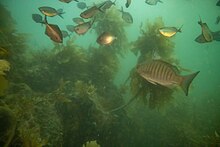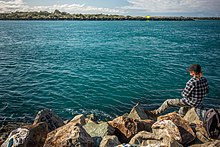
The black sea bass is a species of marine ray-finned fish, a sea bass from the subfamily Serraninae which is part of the family Serranidae, which also includes the groupers and anthias. It is found in the western Atlantic Ocean, where it is an important species for commercial and recreational fisheries.

The foxface rabbitfish, also known as the foxface, black-face rabbit fish, badger fish or the common foxface is a species of marine ray-finned fish, a rabbitfish belonging to the family Siganidae. It is found in the Indian and Pacific Oceans. It can be found in the aquarium trade.

The lane snapper, the Mexican snapper, redtail snapper or spot snapper, is a species of marine ray-finned fish, a snapper belonging to the family Lutjanidae. It is native to the western Atlantic Ocean.

The blue maomao, also known as the violet sweep, blue sweep or hardbelly, is a species of marine ray-finned fish, a member of the subfamily Scorpidinae, part of the sea chub family Kyphosidae. It is native to the southwestern Pacific Ocean from Australia to New Zealand and the Kermadec Islands, where it can be found in inshore waters from the surface to depths of 30 m (98 ft). This fish can reach a length of 40 cm (16 in). It is commercially important and is also a popular game fish.

Aplodactylus arctidens, the marblefish or southern seacarp, is a species of marine ray finned fish, one of the marblefishes belonging to the family Aplodactylidae. It is found in the southwestern Pacific Ocean.

Girella cyanea, also known as the blue drummer or Australian bluefish, is a species of sea chub native to inshore waters, around 6 metres (20 ft) depth, from Australia to New Zealand and the Kermadec Islands. Sightings were first recorded in 1881 but the species made its debut in scientific publications in 1919 in Theodore Roughly's Fishes of Australia and Their Technology.

Helicolenus percoides, the reef ocean perch, coral cod, coral perch, Jock Stewart, kuriarki, ocean perch, red gurnard perch, red gurnard scorpionfish, red ocean perch, red perch, red rock perch, scarpee or sea perch, is a species of marine ray-finned fish belonging to the subfamily Sebastinae, part of the family Scorpaenidae. It is found in the southwestern Pacific Ocean.

The Microcanthinae, commonly known as footballers, mados, stripeys, and moonlighters, are a subfamily of the sea chubs, a family of marine ray-finned fish in the order Perciformes.
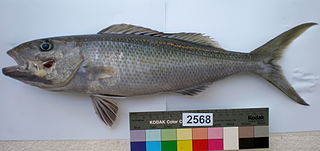
The green jobfish, also known as the gray jobfish, gray snapper, or slender snapper, and in Hawaiian as uku, is a species of marine ray-finned fish, a snapper belonging to the family Lutjanidae. It is found in the Indo-Pacific region. This species inhabits various reef environments at depths from near the surface to 120 metres (390 ft). It is a very important species for local commercial fisheries and is popular as a game fish, though it has been reported to cause ciguatera poisoning. It can also be found in the aquarium trade. This species is the only known member of its genus.
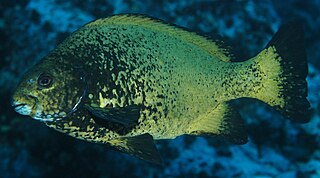
Girella is a genus of ray-finned fish mostly native to the Pacific Ocean with a smaller presence in the Atlantic oceans.
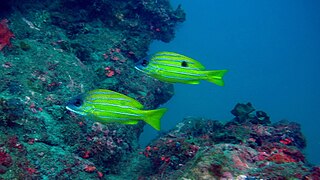
Lutjanus quinquelineatus, the five-lined snapper, blue-striped snapper, blue-banded sea-perch, five-lined seaperch or gold-striped sea-perch, is a species of ray-finned fish, a snapper belonging to the family Lutjanidae. It is native to the Indian Ocean and the western Pacific Ocean.

Girella nigricans, commonly known as the opaleye or rudderfish, is a species of sea chub found in the Eastern Pacific, from California to southern Baja California. A rarely documented isolated population also exists in the Gulf of California, which might be genetically different from the rest of the species. They are commonly found in shallow waters and intertidal zones, usually over rocks and kelp beds, at depths of 1 to 32 m. They feed primarily on algae, but will occasionally consume sessile invertebrates. They are considered commercially important game fish.

Pomadasys kaakan, the javelin grunter or barred javelin is a species of marine ray-finned fish, a grunt belonging to the family Haemulidae. It is native to the Indian and Pacific Oceans, from Africa to Australia.
Pristipomoides flavipinnis, the golden eye jobfish or golden eye snapper, is a species of ray-finned fish, a snapper belonging to the family Lutjanidae. It is found in the Pacific Ocean.

Girella elevata, the rock blackfish, Eastern rock blackfish, black rockfish or Eastern rock blackfish drummer is a species of marine ray-finned fish, a sea chub from the family Kyphosidae. It is found in the southwestern Pacific Ocean around eastern Australia and northern New Zealand.

Girella zebra, also known as zebrafish or stripey bream, is a species of marine ray-finned fish, a sea chub in the family Kyphosidae. It lives in the Indo-Pacific, where it is endemic to the coastal waters of the southern parts of Australia.

Kyphosus bigibbus, the brown chub, grey drummer, darkfin drummer, insular rudderfish, grey chub, grey sea chub, southern drummer or topsail drummer is a species of marine ray-finned fish, a sea chub from the family Kyphosidae. It is a herbivorous species which is found in subtropical and tropical seas worldwide.

The rock cale, also known as the cockatoo fish, cocky, joey, rock cocky or sea carp, is a species of marine ray finned fish, one of the marblefishes belonging to the family Aplodactylidae. It is found in the southwestern Pacific Ocean.

Siganus spinus, the little spinefoot, scribbled rabbitfish, blunt-nosed spinefoot, spiny rabbitfish, or spiny spinefoot, is a species of marine ray-finned fish, a rabbitfish belonging to the family Siganidae. It is found in the Indo-Pacific region.
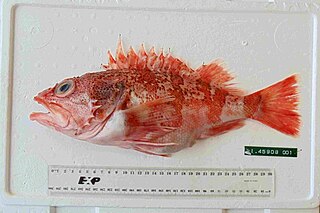
Helicolenus barathri, the bigeye sea perch, bigeye ocean perch, coral cod, coral perch, red gurnard perch, red perch or red rock perch, is a species of marine ray-finned fish belonging to the subfamily Sebastinae, part of the family Scorpaenidae. It is found in the southwestern Pacific Ocean.


